Managerial Accounting: SPMS Implementation and Reward System Analysis
VerifiedAdded on 2019/11/20
|20
|5476
|908
Report
AI Summary
This report provides a comprehensive analysis of Strategic Performance Measurement Systems (SPMS) and their significance in business corporations. It explores the use of multi-perspective SPMS, including balanced scorecards and Triple Bottom Line approaches, detailing their salient features and discussing the relationship between motivational theories and reward systems for both executive and non-executive employees. The report examines SPMS adoption by AGL Energy Limited and Westpac Banking Corporation, revealing that Westpac has a more quantitative and strategically aligned system, linking corporate objectives with key performance indicators and executive rewards. The report highlights the importance of integrating SPMS with compensation plans to achieve organizational goals and gain a competitive advantage, supported by a literature review on the salient features of SPMS and its impact on business transparency and stakeholder trust. The report also emphasizes the role of SPMS in measuring non-financial information and its contribution to the intellectual capital of the company.

Managerial Accounting
Paraphrase This Document
Need a fresh take? Get an instant paraphrase of this document with our AI Paraphraser
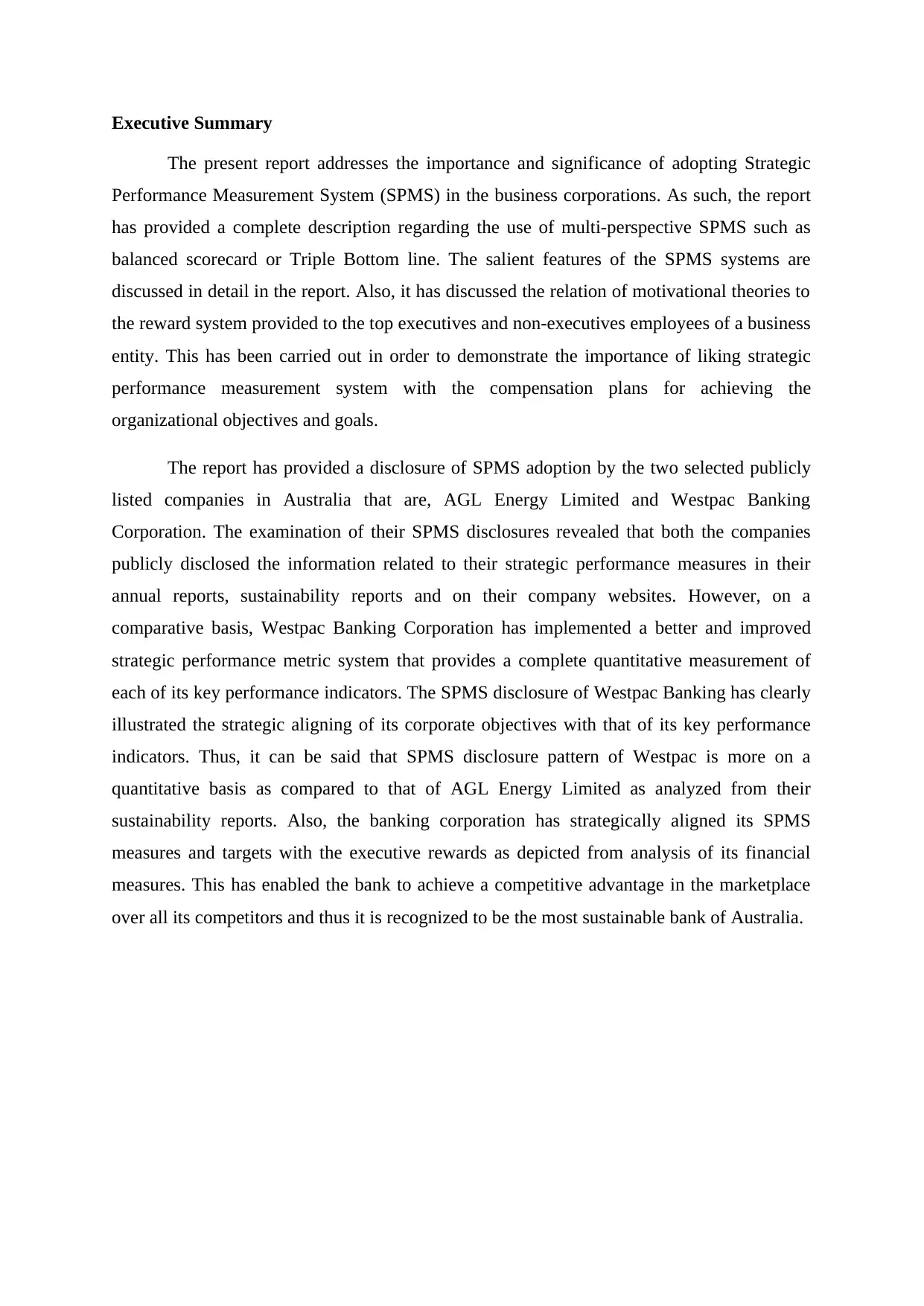
Executive Summary
The present report addresses the importance and significance of adopting Strategic
Performance Measurement System (SPMS) in the business corporations. As such, the report
has provided a complete description regarding the use of multi-perspective SPMS such as
balanced scorecard or Triple Bottom line. The salient features of the SPMS systems are
discussed in detail in the report. Also, it has discussed the relation of motivational theories to
the reward system provided to the top executives and non-executives employees of a business
entity. This has been carried out in order to demonstrate the importance of liking strategic
performance measurement system with the compensation plans for achieving the
organizational objectives and goals.
The report has provided a disclosure of SPMS adoption by the two selected publicly
listed companies in Australia that are, AGL Energy Limited and Westpac Banking
Corporation. The examination of their SPMS disclosures revealed that both the companies
publicly disclosed the information related to their strategic performance measures in their
annual reports, sustainability reports and on their company websites. However, on a
comparative basis, Westpac Banking Corporation has implemented a better and improved
strategic performance metric system that provides a complete quantitative measurement of
each of its key performance indicators. The SPMS disclosure of Westpac Banking has clearly
illustrated the strategic aligning of its corporate objectives with that of its key performance
indicators. Thus, it can be said that SPMS disclosure pattern of Westpac is more on a
quantitative basis as compared to that of AGL Energy Limited as analyzed from their
sustainability reports. Also, the banking corporation has strategically aligned its SPMS
measures and targets with the executive rewards as depicted from analysis of its financial
measures. This has enabled the bank to achieve a competitive advantage in the marketplace
over all its competitors and thus it is recognized to be the most sustainable bank of Australia.
The present report addresses the importance and significance of adopting Strategic
Performance Measurement System (SPMS) in the business corporations. As such, the report
has provided a complete description regarding the use of multi-perspective SPMS such as
balanced scorecard or Triple Bottom line. The salient features of the SPMS systems are
discussed in detail in the report. Also, it has discussed the relation of motivational theories to
the reward system provided to the top executives and non-executives employees of a business
entity. This has been carried out in order to demonstrate the importance of liking strategic
performance measurement system with the compensation plans for achieving the
organizational objectives and goals.
The report has provided a disclosure of SPMS adoption by the two selected publicly
listed companies in Australia that are, AGL Energy Limited and Westpac Banking
Corporation. The examination of their SPMS disclosures revealed that both the companies
publicly disclosed the information related to their strategic performance measures in their
annual reports, sustainability reports and on their company websites. However, on a
comparative basis, Westpac Banking Corporation has implemented a better and improved
strategic performance metric system that provides a complete quantitative measurement of
each of its key performance indicators. The SPMS disclosure of Westpac Banking has clearly
illustrated the strategic aligning of its corporate objectives with that of its key performance
indicators. Thus, it can be said that SPMS disclosure pattern of Westpac is more on a
quantitative basis as compared to that of AGL Energy Limited as analyzed from their
sustainability reports. Also, the banking corporation has strategically aligned its SPMS
measures and targets with the executive rewards as depicted from analysis of its financial
measures. This has enabled the bank to achieve a competitive advantage in the marketplace
over all its competitors and thus it is recognized to be the most sustainable bank of Australia.
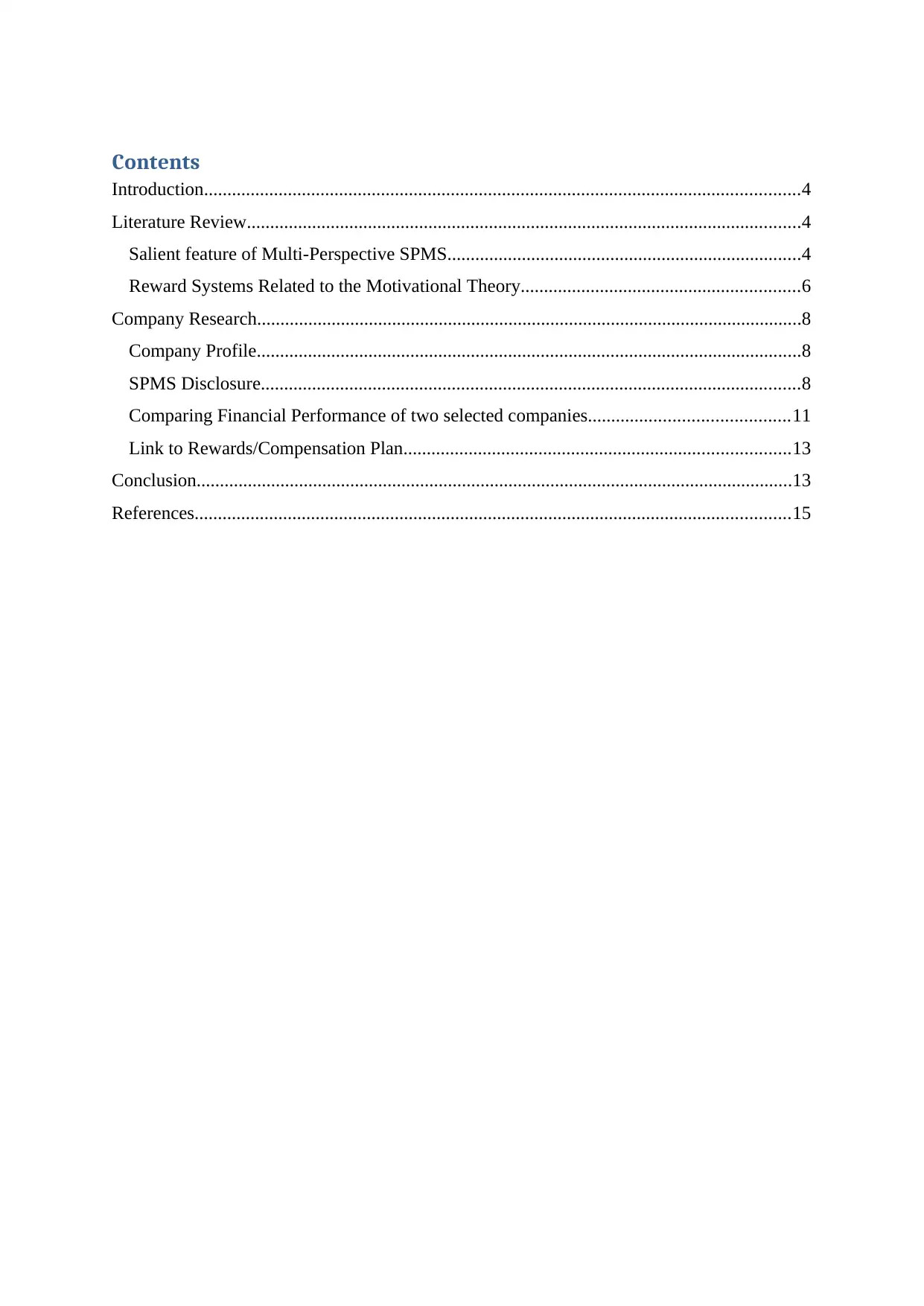
Contents
Introduction................................................................................................................................4
Literature Review.......................................................................................................................4
Salient feature of Multi-Perspective SPMS............................................................................4
Reward Systems Related to the Motivational Theory............................................................6
Company Research.....................................................................................................................8
Company Profile.....................................................................................................................8
SPMS Disclosure....................................................................................................................8
Comparing Financial Performance of two selected companies...........................................11
Link to Rewards/Compensation Plan...................................................................................13
Conclusion................................................................................................................................13
References................................................................................................................................15
Introduction................................................................................................................................4
Literature Review.......................................................................................................................4
Salient feature of Multi-Perspective SPMS............................................................................4
Reward Systems Related to the Motivational Theory............................................................6
Company Research.....................................................................................................................8
Company Profile.....................................................................................................................8
SPMS Disclosure....................................................................................................................8
Comparing Financial Performance of two selected companies...........................................11
Link to Rewards/Compensation Plan...................................................................................13
Conclusion................................................................................................................................13
References................................................................................................................................15
⊘ This is a preview!⊘
Do you want full access?
Subscribe today to unlock all pages.

Trusted by 1+ million students worldwide
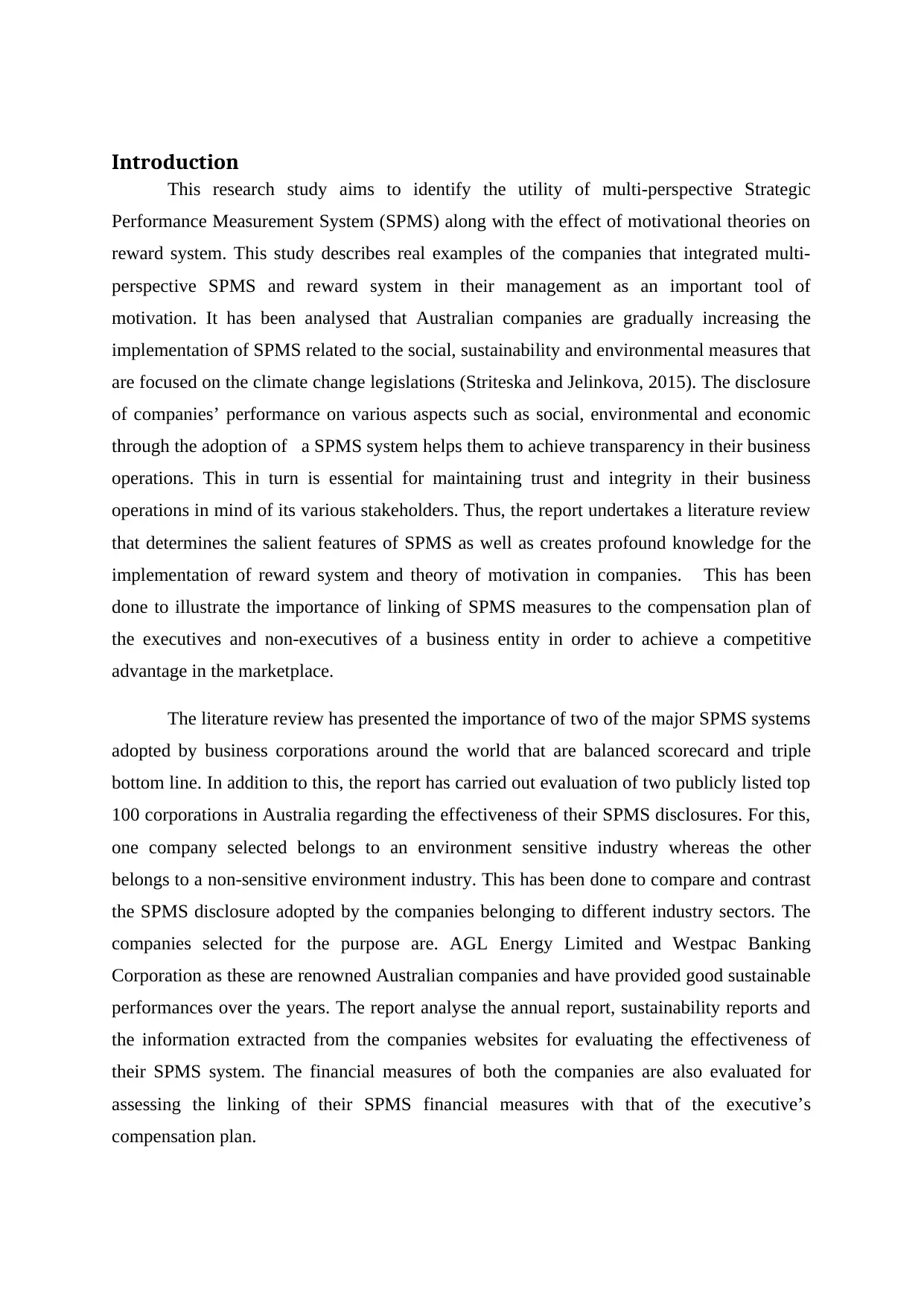
Introduction
This research study aims to identify the utility of multi-perspective Strategic
Performance Measurement System (SPMS) along with the effect of motivational theories on
reward system. This study describes real examples of the companies that integrated multi-
perspective SPMS and reward system in their management as an important tool of
motivation. It has been analysed that Australian companies are gradually increasing the
implementation of SPMS related to the social, sustainability and environmental measures that
are focused on the climate change legislations (Striteska and Jelinkova, 2015). The disclosure
of companies’ performance on various aspects such as social, environmental and economic
through the adoption of a SPMS system helps them to achieve transparency in their business
operations. This in turn is essential for maintaining trust and integrity in their business
operations in mind of its various stakeholders. Thus, the report undertakes a literature review
that determines the salient features of SPMS as well as creates profound knowledge for the
implementation of reward system and theory of motivation in companies. This has been
done to illustrate the importance of linking of SPMS measures to the compensation plan of
the executives and non-executives of a business entity in order to achieve a competitive
advantage in the marketplace.
The literature review has presented the importance of two of the major SPMS systems
adopted by business corporations around the world that are balanced scorecard and triple
bottom line. In addition to this, the report has carried out evaluation of two publicly listed top
100 corporations in Australia regarding the effectiveness of their SPMS disclosures. For this,
one company selected belongs to an environment sensitive industry whereas the other
belongs to a non-sensitive environment industry. This has been done to compare and contrast
the SPMS disclosure adopted by the companies belonging to different industry sectors. The
companies selected for the purpose are. AGL Energy Limited and Westpac Banking
Corporation as these are renowned Australian companies and have provided good sustainable
performances over the years. The report analyse the annual report, sustainability reports and
the information extracted from the companies websites for evaluating the effectiveness of
their SPMS system. The financial measures of both the companies are also evaluated for
assessing the linking of their SPMS financial measures with that of the executive’s
compensation plan.
This research study aims to identify the utility of multi-perspective Strategic
Performance Measurement System (SPMS) along with the effect of motivational theories on
reward system. This study describes real examples of the companies that integrated multi-
perspective SPMS and reward system in their management as an important tool of
motivation. It has been analysed that Australian companies are gradually increasing the
implementation of SPMS related to the social, sustainability and environmental measures that
are focused on the climate change legislations (Striteska and Jelinkova, 2015). The disclosure
of companies’ performance on various aspects such as social, environmental and economic
through the adoption of a SPMS system helps them to achieve transparency in their business
operations. This in turn is essential for maintaining trust and integrity in their business
operations in mind of its various stakeholders. Thus, the report undertakes a literature review
that determines the salient features of SPMS as well as creates profound knowledge for the
implementation of reward system and theory of motivation in companies. This has been
done to illustrate the importance of linking of SPMS measures to the compensation plan of
the executives and non-executives of a business entity in order to achieve a competitive
advantage in the marketplace.
The literature review has presented the importance of two of the major SPMS systems
adopted by business corporations around the world that are balanced scorecard and triple
bottom line. In addition to this, the report has carried out evaluation of two publicly listed top
100 corporations in Australia regarding the effectiveness of their SPMS disclosures. For this,
one company selected belongs to an environment sensitive industry whereas the other
belongs to a non-sensitive environment industry. This has been done to compare and contrast
the SPMS disclosure adopted by the companies belonging to different industry sectors. The
companies selected for the purpose are. AGL Energy Limited and Westpac Banking
Corporation as these are renowned Australian companies and have provided good sustainable
performances over the years. The report analyse the annual report, sustainability reports and
the information extracted from the companies websites for evaluating the effectiveness of
their SPMS system. The financial measures of both the companies are also evaluated for
assessing the linking of their SPMS financial measures with that of the executive’s
compensation plan.
Paraphrase This Document
Need a fresh take? Get an instant paraphrase of this document with our AI Paraphraser
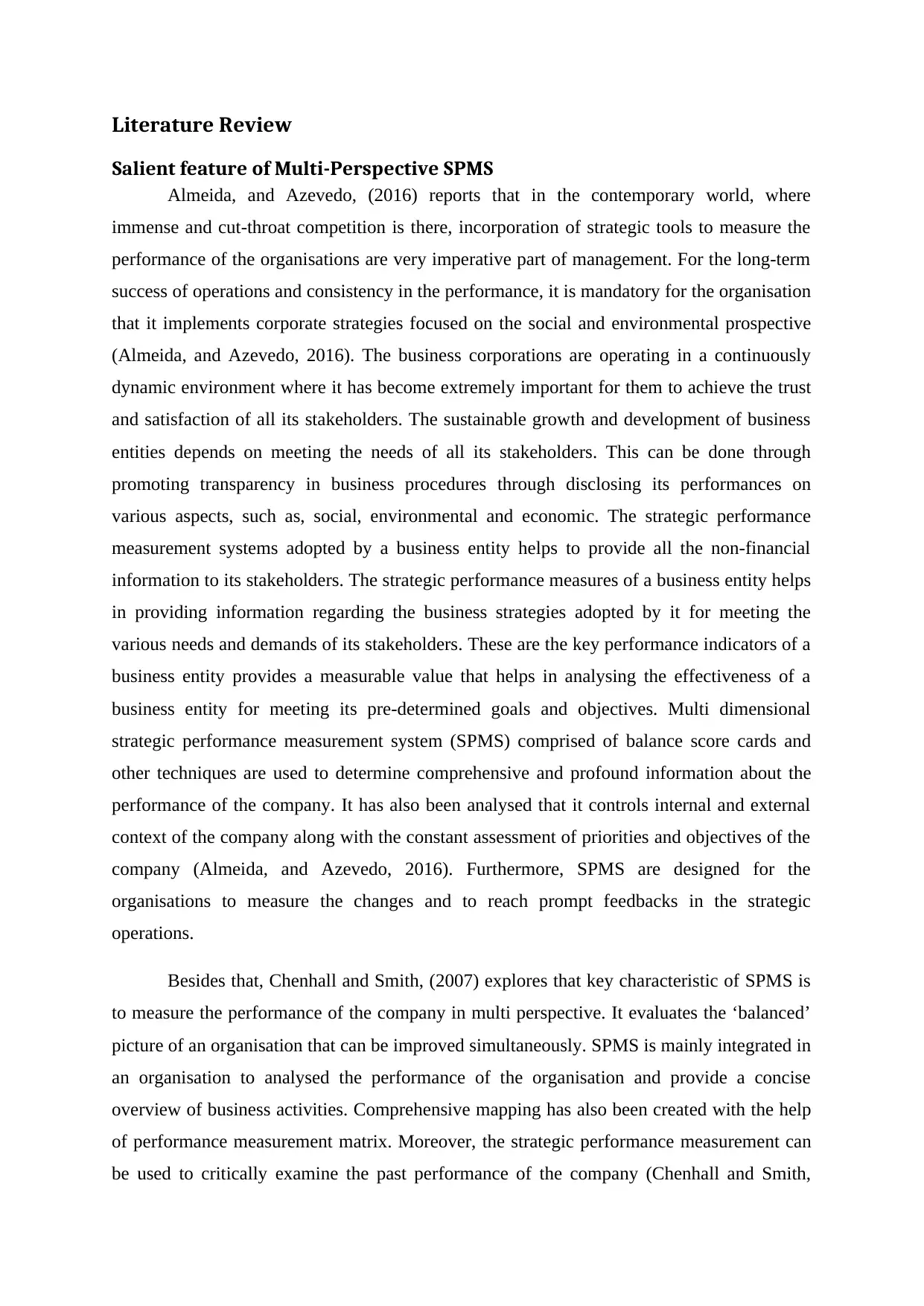
Literature Review
Salient feature of Multi-Perspective SPMS
Almeida, and Azevedo, (2016) reports that in the contemporary world, where
immense and cut-throat competition is there, incorporation of strategic tools to measure the
performance of the organisations are very imperative part of management. For the long-term
success of operations and consistency in the performance, it is mandatory for the organisation
that it implements corporate strategies focused on the social and environmental prospective
(Almeida, and Azevedo, 2016). The business corporations are operating in a continuously
dynamic environment where it has become extremely important for them to achieve the trust
and satisfaction of all its stakeholders. The sustainable growth and development of business
entities depends on meeting the needs of all its stakeholders. This can be done through
promoting transparency in business procedures through disclosing its performances on
various aspects, such as, social, environmental and economic. The strategic performance
measurement systems adopted by a business entity helps to provide all the non-financial
information to its stakeholders. The strategic performance measures of a business entity helps
in providing information regarding the business strategies adopted by it for meeting the
various needs and demands of its stakeholders. These are the key performance indicators of a
business entity provides a measurable value that helps in analysing the effectiveness of a
business entity for meeting its pre-determined goals and objectives. Multi dimensional
strategic performance measurement system (SPMS) comprised of balance score cards and
other techniques are used to determine comprehensive and profound information about the
performance of the company. It has also been analysed that it controls internal and external
context of the company along with the constant assessment of priorities and objectives of the
company (Almeida, and Azevedo, 2016). Furthermore, SPMS are designed for the
organisations to measure the changes and to reach prompt feedbacks in the strategic
operations.
Besides that, Chenhall and Smith, (2007) explores that key characteristic of SPMS is
to measure the performance of the company in multi perspective. It evaluates the ‘balanced’
picture of an organisation that can be improved simultaneously. SPMS is mainly integrated in
an organisation to analysed the performance of the organisation and provide a concise
overview of business activities. Comprehensive mapping has also been created with the help
of performance measurement matrix. Moreover, the strategic performance measurement can
be used to critically examine the past performance of the company (Chenhall and Smith,
Salient feature of Multi-Perspective SPMS
Almeida, and Azevedo, (2016) reports that in the contemporary world, where
immense and cut-throat competition is there, incorporation of strategic tools to measure the
performance of the organisations are very imperative part of management. For the long-term
success of operations and consistency in the performance, it is mandatory for the organisation
that it implements corporate strategies focused on the social and environmental prospective
(Almeida, and Azevedo, 2016). The business corporations are operating in a continuously
dynamic environment where it has become extremely important for them to achieve the trust
and satisfaction of all its stakeholders. The sustainable growth and development of business
entities depends on meeting the needs of all its stakeholders. This can be done through
promoting transparency in business procedures through disclosing its performances on
various aspects, such as, social, environmental and economic. The strategic performance
measurement systems adopted by a business entity helps to provide all the non-financial
information to its stakeholders. The strategic performance measures of a business entity helps
in providing information regarding the business strategies adopted by it for meeting the
various needs and demands of its stakeholders. These are the key performance indicators of a
business entity provides a measurable value that helps in analysing the effectiveness of a
business entity for meeting its pre-determined goals and objectives. Multi dimensional
strategic performance measurement system (SPMS) comprised of balance score cards and
other techniques are used to determine comprehensive and profound information about the
performance of the company. It has also been analysed that it controls internal and external
context of the company along with the constant assessment of priorities and objectives of the
company (Almeida, and Azevedo, 2016). Furthermore, SPMS are designed for the
organisations to measure the changes and to reach prompt feedbacks in the strategic
operations.
Besides that, Chenhall and Smith, (2007) explores that key characteristic of SPMS is
to measure the performance of the company in multi perspective. It evaluates the ‘balanced’
picture of an organisation that can be improved simultaneously. SPMS is mainly integrated in
an organisation to analysed the performance of the organisation and provide a concise
overview of business activities. Comprehensive mapping has also been created with the help
of performance measurement matrix. Moreover, the strategic performance measurement can
be used to critically examine the past performance of the company (Chenhall and Smith,

2007). The future planning for the performance of the organisation to set parameters can also
be incorporated through SPMS. Some of the models of SPMS are SMART performance
pyramid, the performance pyramid, performance prism and the performance measurement
matrix. Furthermore, the performance measurement system is comprised of balance scorecard
and EFQM business excellence model (Chenhall and Smith, 2007).
On the other hand, Iselin, Sands and Mia, (2009) states that the balance scorecards has
four perspectives that is financial, customers, internal business process and learning and
growth which help the organisations in achieving strategic goals and objectives. These factors
facilitate measurement of performance through variables like revenue, cost/productivity, asset
utilisation and investment strategies for the financial performance evaluation. In addition to
this, customer satisfaction, profitability of customers, customers acquisition, retention and
market shares are other parameters and data that provides wide information about the
customers. Post sale service, innovation and quality of the operations emphasises on the
internal business processes (Iselin, Sands and Mia, 2009). However, motivation,
configuration and empowerment with information system capability and employee capability
dimensions are analysed as learning and growth features of the company. The performance
factors measured by balanced scorecard can be illustrated as:
Striteska and Spickova (2012) describes that the use of triple bottom line as a
performance measurement system can be highlighted in three stages which can help the
organisation in achieving the strategic goals that includes environmental, social and financial
be incorporated through SPMS. Some of the models of SPMS are SMART performance
pyramid, the performance pyramid, performance prism and the performance measurement
matrix. Furthermore, the performance measurement system is comprised of balance scorecard
and EFQM business excellence model (Chenhall and Smith, 2007).
On the other hand, Iselin, Sands and Mia, (2009) states that the balance scorecards has
four perspectives that is financial, customers, internal business process and learning and
growth which help the organisations in achieving strategic goals and objectives. These factors
facilitate measurement of performance through variables like revenue, cost/productivity, asset
utilisation and investment strategies for the financial performance evaluation. In addition to
this, customer satisfaction, profitability of customers, customers acquisition, retention and
market shares are other parameters and data that provides wide information about the
customers. Post sale service, innovation and quality of the operations emphasises on the
internal business processes (Iselin, Sands and Mia, 2009). However, motivation,
configuration and empowerment with information system capability and employee capability
dimensions are analysed as learning and growth features of the company. The performance
factors measured by balanced scorecard can be illustrated as:
Striteska and Spickova (2012) describes that the use of triple bottom line as a
performance measurement system can be highlighted in three stages which can help the
organisation in achieving the strategic goals that includes environmental, social and financial
⊘ This is a preview!⊘
Do you want full access?
Subscribe today to unlock all pages.

Trusted by 1+ million students worldwide
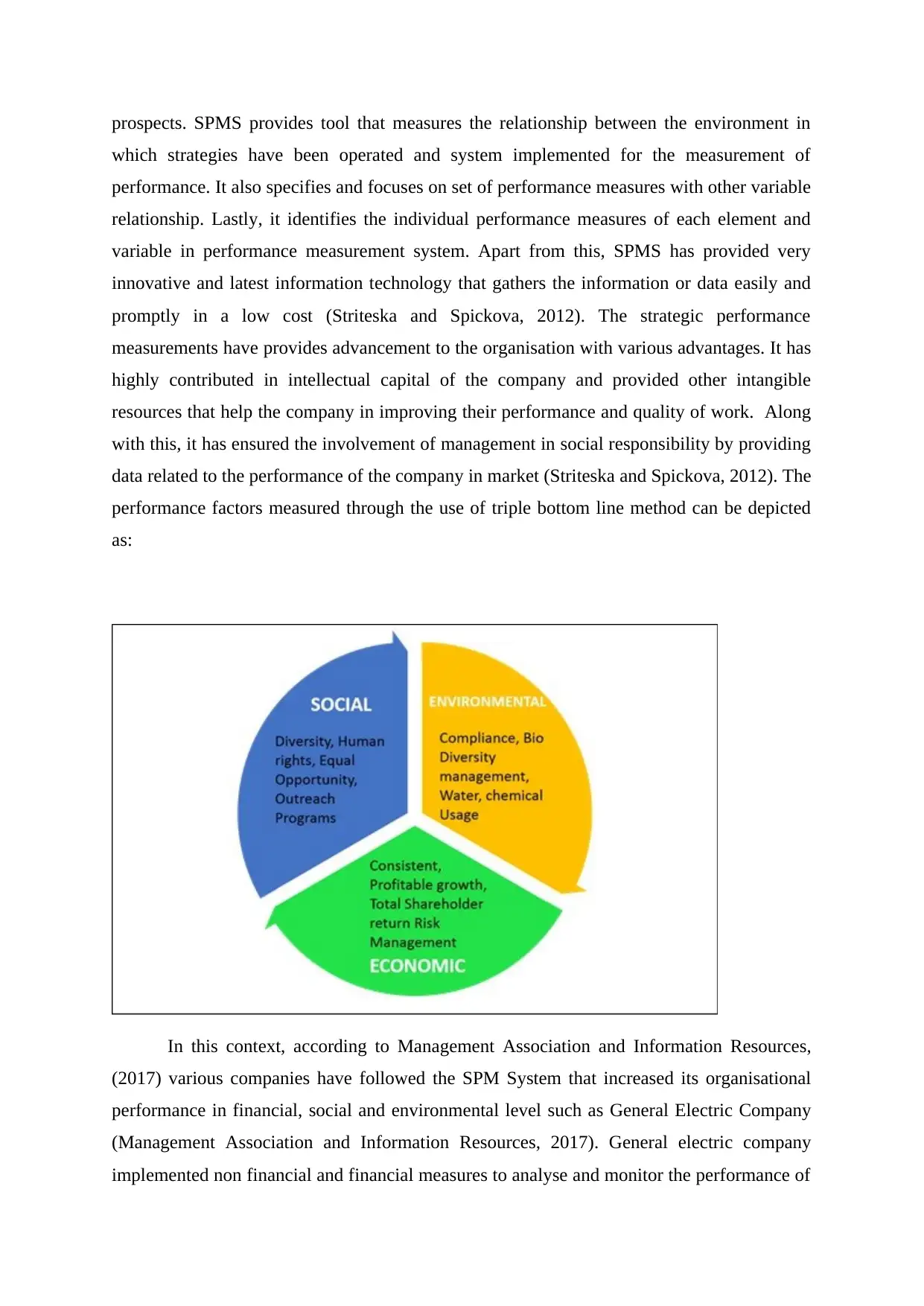
prospects. SPMS provides tool that measures the relationship between the environment in
which strategies have been operated and system implemented for the measurement of
performance. It also specifies and focuses on set of performance measures with other variable
relationship. Lastly, it identifies the individual performance measures of each element and
variable in performance measurement system. Apart from this, SPMS has provided very
innovative and latest information technology that gathers the information or data easily and
promptly in a low cost (Striteska and Spickova, 2012). The strategic performance
measurements have provides advancement to the organisation with various advantages. It has
highly contributed in intellectual capital of the company and provided other intangible
resources that help the company in improving their performance and quality of work. Along
with this, it has ensured the involvement of management in social responsibility by providing
data related to the performance of the company in market (Striteska and Spickova, 2012). The
performance factors measured through the use of triple bottom line method can be depicted
as:
In this context, according to Management Association and Information Resources,
(2017) various companies have followed the SPM System that increased its organisational
performance in financial, social and environmental level such as General Electric Company
(Management Association and Information Resources, 2017). General electric company
implemented non financial and financial measures to analyse and monitor the performance of
which strategies have been operated and system implemented for the measurement of
performance. It also specifies and focuses on set of performance measures with other variable
relationship. Lastly, it identifies the individual performance measures of each element and
variable in performance measurement system. Apart from this, SPMS has provided very
innovative and latest information technology that gathers the information or data easily and
promptly in a low cost (Striteska and Spickova, 2012). The strategic performance
measurements have provides advancement to the organisation with various advantages. It has
highly contributed in intellectual capital of the company and provided other intangible
resources that help the company in improving their performance and quality of work. Along
with this, it has ensured the involvement of management in social responsibility by providing
data related to the performance of the company in market (Striteska and Spickova, 2012). The
performance factors measured through the use of triple bottom line method can be depicted
as:
In this context, according to Management Association and Information Resources,
(2017) various companies have followed the SPM System that increased its organisational
performance in financial, social and environmental level such as General Electric Company
(Management Association and Information Resources, 2017). General electric company
implemented non financial and financial measures to analyse and monitor the performance of
Paraphrase This Document
Need a fresh take? Get an instant paraphrase of this document with our AI Paraphraser
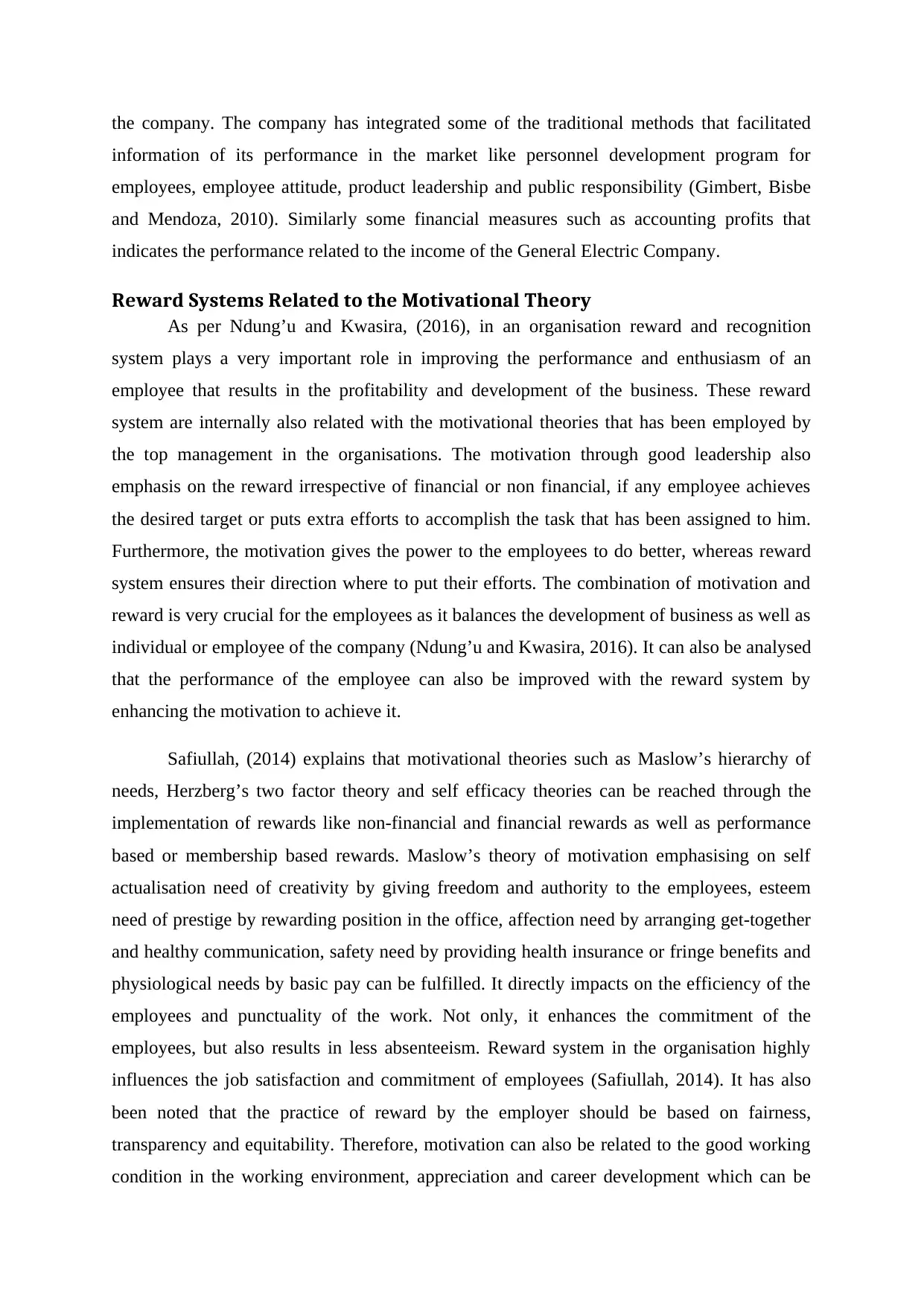
the company. The company has integrated some of the traditional methods that facilitated
information of its performance in the market like personnel development program for
employees, employee attitude, product leadership and public responsibility (Gimbert, Bisbe
and Mendoza, 2010). Similarly some financial measures such as accounting profits that
indicates the performance related to the income of the General Electric Company.
Reward Systems Related to the Motivational Theory
As per Ndung’u and Kwasira, (2016), in an organisation reward and recognition
system plays a very important role in improving the performance and enthusiasm of an
employee that results in the profitability and development of the business. These reward
system are internally also related with the motivational theories that has been employed by
the top management in the organisations. The motivation through good leadership also
emphasis on the reward irrespective of financial or non financial, if any employee achieves
the desired target or puts extra efforts to accomplish the task that has been assigned to him.
Furthermore, the motivation gives the power to the employees to do better, whereas reward
system ensures their direction where to put their efforts. The combination of motivation and
reward is very crucial for the employees as it balances the development of business as well as
individual or employee of the company (Ndung’u and Kwasira, 2016). It can also be analysed
that the performance of the employee can also be improved with the reward system by
enhancing the motivation to achieve it.
Safiullah, (2014) explains that motivational theories such as Maslow’s hierarchy of
needs, Herzberg’s two factor theory and self efficacy theories can be reached through the
implementation of rewards like non-financial and financial rewards as well as performance
based or membership based rewards. Maslow’s theory of motivation emphasising on self
actualisation need of creativity by giving freedom and authority to the employees, esteem
need of prestige by rewarding position in the office, affection need by arranging get-together
and healthy communication, safety need by providing health insurance or fringe benefits and
physiological needs by basic pay can be fulfilled. It directly impacts on the efficiency of the
employees and punctuality of the work. Not only, it enhances the commitment of the
employees, but also results in less absenteeism. Reward system in the organisation highly
influences the job satisfaction and commitment of employees (Safiullah, 2014). It has also
been noted that the practice of reward by the employer should be based on fairness,
transparency and equitability. Therefore, motivation can also be related to the good working
condition in the working environment, appreciation and career development which can be
information of its performance in the market like personnel development program for
employees, employee attitude, product leadership and public responsibility (Gimbert, Bisbe
and Mendoza, 2010). Similarly some financial measures such as accounting profits that
indicates the performance related to the income of the General Electric Company.
Reward Systems Related to the Motivational Theory
As per Ndung’u and Kwasira, (2016), in an organisation reward and recognition
system plays a very important role in improving the performance and enthusiasm of an
employee that results in the profitability and development of the business. These reward
system are internally also related with the motivational theories that has been employed by
the top management in the organisations. The motivation through good leadership also
emphasis on the reward irrespective of financial or non financial, if any employee achieves
the desired target or puts extra efforts to accomplish the task that has been assigned to him.
Furthermore, the motivation gives the power to the employees to do better, whereas reward
system ensures their direction where to put their efforts. The combination of motivation and
reward is very crucial for the employees as it balances the development of business as well as
individual or employee of the company (Ndung’u and Kwasira, 2016). It can also be analysed
that the performance of the employee can also be improved with the reward system by
enhancing the motivation to achieve it.
Safiullah, (2014) explains that motivational theories such as Maslow’s hierarchy of
needs, Herzberg’s two factor theory and self efficacy theories can be reached through the
implementation of rewards like non-financial and financial rewards as well as performance
based or membership based rewards. Maslow’s theory of motivation emphasising on self
actualisation need of creativity by giving freedom and authority to the employees, esteem
need of prestige by rewarding position in the office, affection need by arranging get-together
and healthy communication, safety need by providing health insurance or fringe benefits and
physiological needs by basic pay can be fulfilled. It directly impacts on the efficiency of the
employees and punctuality of the work. Not only, it enhances the commitment of the
employees, but also results in less absenteeism. Reward system in the organisation highly
influences the job satisfaction and commitment of employees (Safiullah, 2014). It has also
been noted that the practice of reward by the employer should be based on fairness,
transparency and equitability. Therefore, motivation can also be related to the good working
condition in the working environment, appreciation and career development which can be

ensured as reward to the employees. The reward system with apt motivation results in
increase in productivity and performance of employee. In real life scenario, there are various
companies such as Apple, Woolworths, Toyota that provides motivation to the employees
with the reward as an achievement and successful in raising their profitability in the market
(Safiullah, 2014). In addition to this, these organisations are continuously improving their
internal environment by strengthening their manpower resource.
In the view of Ranjan and Mishra, (2017), as an example, Motonet-Espoo has
integrated such a reward system for its employees that motivate them to increase their
performance and productivity. The process of decision making regarding the reward system
in the company was also been taken with the help of employees. The system has also
improved the job satisfaction in employees and increases their motivation as well. The result
has also attained enhancement in the employee’s engagement in the business activities of
Motonet-Espoo. The reward system of the company is being decided by the top level
management. It is a retail store and therefore, there are different levels of store mangers that
help in employing the reward system in each department. The store managers are not static
and consequences in problems that are resolved by learning and development practices
(Ranjan and Mishra, 2017). The employee involvement in feedbacks session every year and
discussion for further improvement also encourages employees in the company. Apart from
this, the store manager that participates in the discussion also changes every year. The reward
has been categorised into three types that is tangible recognition, personal bonus and profit
sharing. Different rewards for full-time and part-employees have been arranged. This system
has immensely changed the working environment of the company in a positive way (Ranjan
and Mishra, 2017). Hence, it can be depicted that there is an affirmative relationship between
the motivational theory and reward from the above text.
Company Research
The present section of the report aims to analyze and examine the Strategic
Performance Measurement System (SPMS) of two top 100 publicly listed companies in
Australia. The companies selected for the purpose are, AGL Energy Limited and Westpac
Banking Corporation. In addition to this, the financial performance of the selected companies
has been analyzed for the year 2015 and 2016 through the adoption of financial measures.
increase in productivity and performance of employee. In real life scenario, there are various
companies such as Apple, Woolworths, Toyota that provides motivation to the employees
with the reward as an achievement and successful in raising their profitability in the market
(Safiullah, 2014). In addition to this, these organisations are continuously improving their
internal environment by strengthening their manpower resource.
In the view of Ranjan and Mishra, (2017), as an example, Motonet-Espoo has
integrated such a reward system for its employees that motivate them to increase their
performance and productivity. The process of decision making regarding the reward system
in the company was also been taken with the help of employees. The system has also
improved the job satisfaction in employees and increases their motivation as well. The result
has also attained enhancement in the employee’s engagement in the business activities of
Motonet-Espoo. The reward system of the company is being decided by the top level
management. It is a retail store and therefore, there are different levels of store mangers that
help in employing the reward system in each department. The store managers are not static
and consequences in problems that are resolved by learning and development practices
(Ranjan and Mishra, 2017). The employee involvement in feedbacks session every year and
discussion for further improvement also encourages employees in the company. Apart from
this, the store manager that participates in the discussion also changes every year. The reward
has been categorised into three types that is tangible recognition, personal bonus and profit
sharing. Different rewards for full-time and part-employees have been arranged. This system
has immensely changed the working environment of the company in a positive way (Ranjan
and Mishra, 2017). Hence, it can be depicted that there is an affirmative relationship between
the motivational theory and reward from the above text.
Company Research
The present section of the report aims to analyze and examine the Strategic
Performance Measurement System (SPMS) of two top 100 publicly listed companies in
Australia. The companies selected for the purpose are, AGL Energy Limited and Westpac
Banking Corporation. In addition to this, the financial performance of the selected companies
has been analyzed for the year 2015 and 2016 through the adoption of financial measures.
⊘ This is a preview!⊘
Do you want full access?
Subscribe today to unlock all pages.

Trusted by 1+ million students worldwide

Company Profile
AGL Energy, an ASX listed public company that is involved in providing energy
products and services to the economy of the country. The company is actively involved in
development and retail of energy related products for both housing and business usage. The
company serves about 3.6 million customers across the country. The company carries out its
business operations through generating thermal, hydro and wind power. The major segments
of the company are energy markets, group operations and data provider business that are
involved in various energy related business activities (About AGL, 2017).
On the other hand, Westpac Banking Corporation, an Australian bank and financial
services provider is recognized as one of big four banks of Australia. It is recognized to be
the first bank of Australia established in the year 1817 by the name of Bank of New South
Wales and in the year 1982 has came to known by the name of Westpac. The banking
corporation serves about 13 million customers across Australia with the main objective of
meeting appropriately their financial goals. The banking corporation aspires to become the
largest company around the world through providing financial assistance to the customers
and communities for promoting their economic prosperity and growth (Westpac Banking
Corporation, 2017).
SPMS Disclosure
The Strategic performance Measurement System (SPMS) has a large impact on the
performance of a business entity as it plays a critical role in developing the strategic
decisions. The Australian firms are placing large emphasis on transforming their performance
measurement systems over the lat years through adopting a strategic performance
measurement system. The strategic performance measurement system provides an analysis of
financial and non-financial performance of a business entity through the adoption of tools
such as Balanced Score Card (BSC). The implementation of multi-perspective approach of
SPMS is essential for AGL Energy Limited as it is an environment sensitive company and
thus need to analyze its performance through the help of adopting environment indicators.
The adoption of a proper environment strategy is essential for AGL as it needs to
continuously monitor the impact of its operational activities on the communities for ensuring
its long-term growth and development. The SPMS will enable quantification of
environmental performance measures and therefore proving beneficial for the company to
measure its sustainable performances (About AGL, 2017).
AGL Energy, an ASX listed public company that is involved in providing energy
products and services to the economy of the country. The company is actively involved in
development and retail of energy related products for both housing and business usage. The
company serves about 3.6 million customers across the country. The company carries out its
business operations through generating thermal, hydro and wind power. The major segments
of the company are energy markets, group operations and data provider business that are
involved in various energy related business activities (About AGL, 2017).
On the other hand, Westpac Banking Corporation, an Australian bank and financial
services provider is recognized as one of big four banks of Australia. It is recognized to be
the first bank of Australia established in the year 1817 by the name of Bank of New South
Wales and in the year 1982 has came to known by the name of Westpac. The banking
corporation serves about 13 million customers across Australia with the main objective of
meeting appropriately their financial goals. The banking corporation aspires to become the
largest company around the world through providing financial assistance to the customers
and communities for promoting their economic prosperity and growth (Westpac Banking
Corporation, 2017).
SPMS Disclosure
The Strategic performance Measurement System (SPMS) has a large impact on the
performance of a business entity as it plays a critical role in developing the strategic
decisions. The Australian firms are placing large emphasis on transforming their performance
measurement systems over the lat years through adopting a strategic performance
measurement system. The strategic performance measurement system provides an analysis of
financial and non-financial performance of a business entity through the adoption of tools
such as Balanced Score Card (BSC). The implementation of multi-perspective approach of
SPMS is essential for AGL Energy Limited as it is an environment sensitive company and
thus need to analyze its performance through the help of adopting environment indicators.
The adoption of a proper environment strategy is essential for AGL as it needs to
continuously monitor the impact of its operational activities on the communities for ensuring
its long-term growth and development. The SPMS will enable quantification of
environmental performance measures and therefore proving beneficial for the company to
measure its sustainable performances (About AGL, 2017).
Paraphrase This Document
Need a fresh take? Get an instant paraphrase of this document with our AI Paraphraser
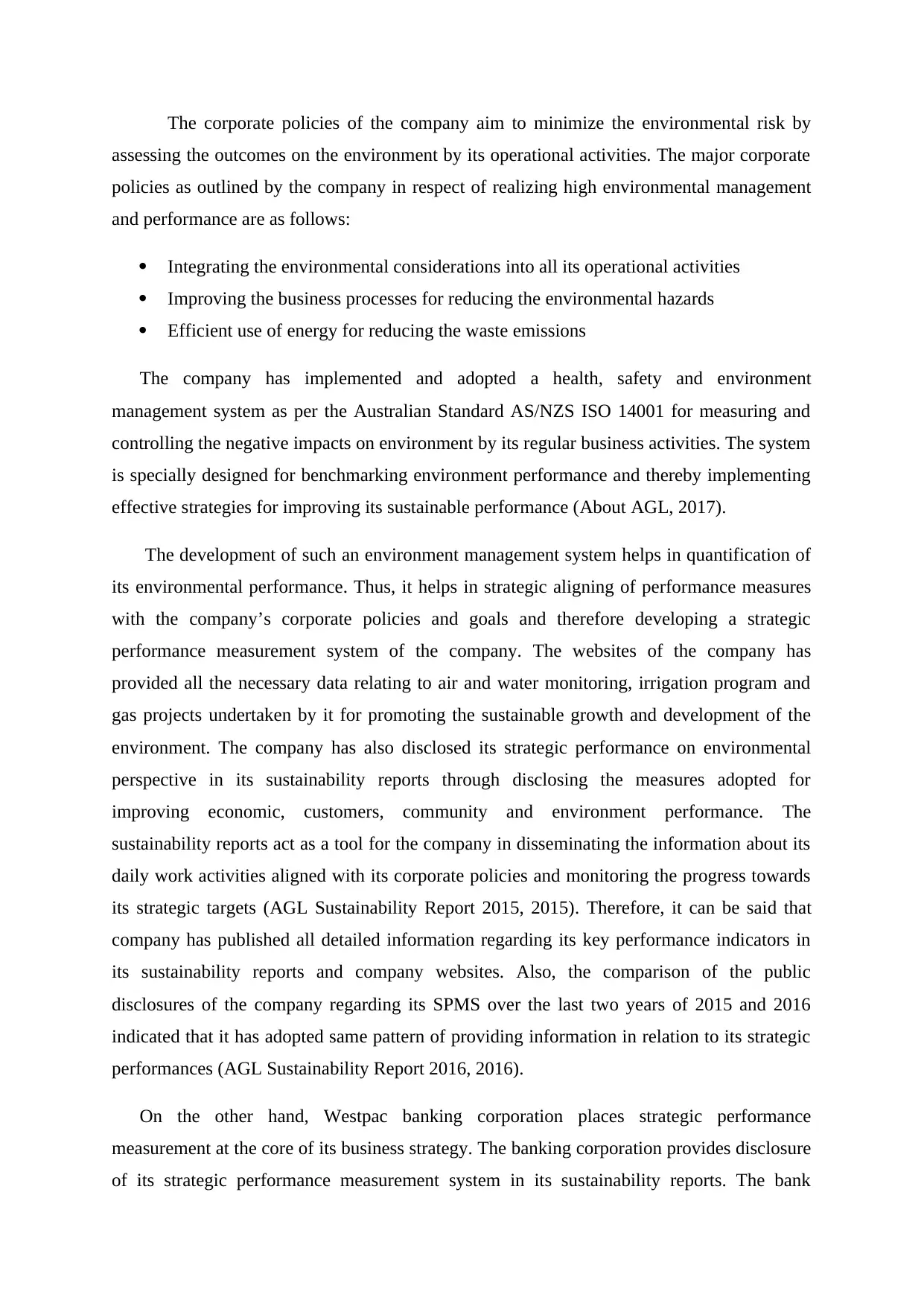
The corporate policies of the company aim to minimize the environmental risk by
assessing the outcomes on the environment by its operational activities. The major corporate
policies as outlined by the company in respect of realizing high environmental management
and performance are as follows:
Integrating the environmental considerations into all its operational activities
Improving the business processes for reducing the environmental hazards
Efficient use of energy for reducing the waste emissions
The company has implemented and adopted a health, safety and environment
management system as per the Australian Standard AS/NZS ISO 14001 for measuring and
controlling the negative impacts on environment by its regular business activities. The system
is specially designed for benchmarking environment performance and thereby implementing
effective strategies for improving its sustainable performance (About AGL, 2017).
The development of such an environment management system helps in quantification of
its environmental performance. Thus, it helps in strategic aligning of performance measures
with the company’s corporate policies and goals and therefore developing a strategic
performance measurement system of the company. The websites of the company has
provided all the necessary data relating to air and water monitoring, irrigation program and
gas projects undertaken by it for promoting the sustainable growth and development of the
environment. The company has also disclosed its strategic performance on environmental
perspective in its sustainability reports through disclosing the measures adopted for
improving economic, customers, community and environment performance. The
sustainability reports act as a tool for the company in disseminating the information about its
daily work activities aligned with its corporate policies and monitoring the progress towards
its strategic targets (AGL Sustainability Report 2015, 2015). Therefore, it can be said that
company has published all detailed information regarding its key performance indicators in
its sustainability reports and company websites. Also, the comparison of the public
disclosures of the company regarding its SPMS over the last two years of 2015 and 2016
indicated that it has adopted same pattern of providing information in relation to its strategic
performances (AGL Sustainability Report 2016, 2016).
On the other hand, Westpac banking corporation places strategic performance
measurement at the core of its business strategy. The banking corporation provides disclosure
of its strategic performance measurement system in its sustainability reports. The bank
assessing the outcomes on the environment by its operational activities. The major corporate
policies as outlined by the company in respect of realizing high environmental management
and performance are as follows:
Integrating the environmental considerations into all its operational activities
Improving the business processes for reducing the environmental hazards
Efficient use of energy for reducing the waste emissions
The company has implemented and adopted a health, safety and environment
management system as per the Australian Standard AS/NZS ISO 14001 for measuring and
controlling the negative impacts on environment by its regular business activities. The system
is specially designed for benchmarking environment performance and thereby implementing
effective strategies for improving its sustainable performance (About AGL, 2017).
The development of such an environment management system helps in quantification of
its environmental performance. Thus, it helps in strategic aligning of performance measures
with the company’s corporate policies and goals and therefore developing a strategic
performance measurement system of the company. The websites of the company has
provided all the necessary data relating to air and water monitoring, irrigation program and
gas projects undertaken by it for promoting the sustainable growth and development of the
environment. The company has also disclosed its strategic performance on environmental
perspective in its sustainability reports through disclosing the measures adopted for
improving economic, customers, community and environment performance. The
sustainability reports act as a tool for the company in disseminating the information about its
daily work activities aligned with its corporate policies and monitoring the progress towards
its strategic targets (AGL Sustainability Report 2015, 2015). Therefore, it can be said that
company has published all detailed information regarding its key performance indicators in
its sustainability reports and company websites. Also, the comparison of the public
disclosures of the company regarding its SPMS over the last two years of 2015 and 2016
indicated that it has adopted same pattern of providing information in relation to its strategic
performances (AGL Sustainability Report 2016, 2016).
On the other hand, Westpac banking corporation places strategic performance
measurement at the core of its business strategy. The banking corporation provides disclosure
of its strategic performance measurement system in its sustainability reports. The bank
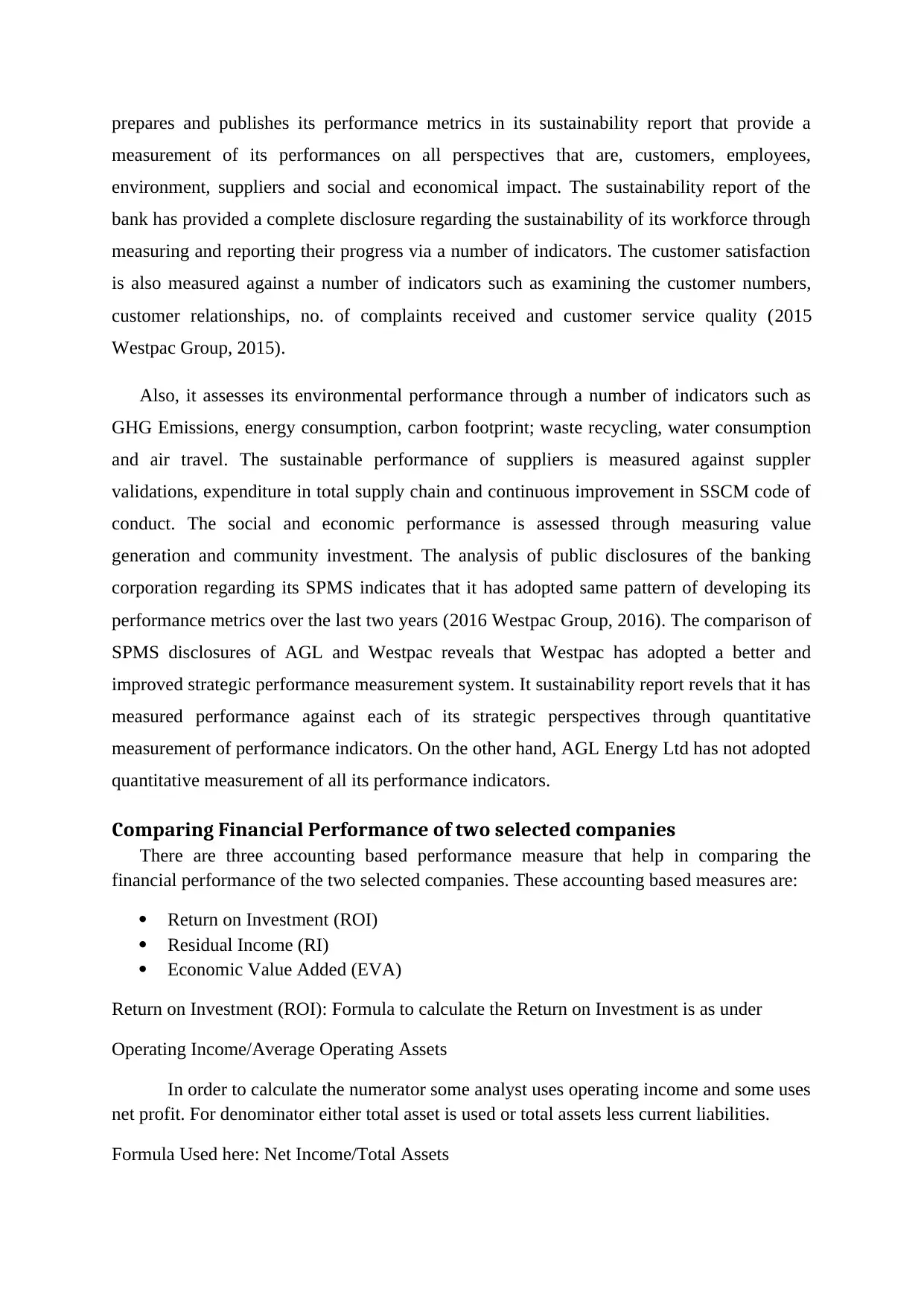
prepares and publishes its performance metrics in its sustainability report that provide a
measurement of its performances on all perspectives that are, customers, employees,
environment, suppliers and social and economical impact. The sustainability report of the
bank has provided a complete disclosure regarding the sustainability of its workforce through
measuring and reporting their progress via a number of indicators. The customer satisfaction
is also measured against a number of indicators such as examining the customer numbers,
customer relationships, no. of complaints received and customer service quality (2015
Westpac Group, 2015).
Also, it assesses its environmental performance through a number of indicators such as
GHG Emissions, energy consumption, carbon footprint; waste recycling, water consumption
and air travel. The sustainable performance of suppliers is measured against suppler
validations, expenditure in total supply chain and continuous improvement in SSCM code of
conduct. The social and economic performance is assessed through measuring value
generation and community investment. The analysis of public disclosures of the banking
corporation regarding its SPMS indicates that it has adopted same pattern of developing its
performance metrics over the last two years (2016 Westpac Group, 2016). The comparison of
SPMS disclosures of AGL and Westpac reveals that Westpac has adopted a better and
improved strategic performance measurement system. It sustainability report revels that it has
measured performance against each of its strategic perspectives through quantitative
measurement of performance indicators. On the other hand, AGL Energy Ltd has not adopted
quantitative measurement of all its performance indicators.
Comparing Financial Performance of two selected companies
There are three accounting based performance measure that help in comparing the
financial performance of the two selected companies. These accounting based measures are:
Return on Investment (ROI)
Residual Income (RI)
Economic Value Added (EVA)
Return on Investment (ROI): Formula to calculate the Return on Investment is as under
Operating Income/Average Operating Assets
In order to calculate the numerator some analyst uses operating income and some uses
net profit. For denominator either total asset is used or total assets less current liabilities.
Formula Used here: Net Income/Total Assets
measurement of its performances on all perspectives that are, customers, employees,
environment, suppliers and social and economical impact. The sustainability report of the
bank has provided a complete disclosure regarding the sustainability of its workforce through
measuring and reporting their progress via a number of indicators. The customer satisfaction
is also measured against a number of indicators such as examining the customer numbers,
customer relationships, no. of complaints received and customer service quality (2015
Westpac Group, 2015).
Also, it assesses its environmental performance through a number of indicators such as
GHG Emissions, energy consumption, carbon footprint; waste recycling, water consumption
and air travel. The sustainable performance of suppliers is measured against suppler
validations, expenditure in total supply chain and continuous improvement in SSCM code of
conduct. The social and economic performance is assessed through measuring value
generation and community investment. The analysis of public disclosures of the banking
corporation regarding its SPMS indicates that it has adopted same pattern of developing its
performance metrics over the last two years (2016 Westpac Group, 2016). The comparison of
SPMS disclosures of AGL and Westpac reveals that Westpac has adopted a better and
improved strategic performance measurement system. It sustainability report revels that it has
measured performance against each of its strategic perspectives through quantitative
measurement of performance indicators. On the other hand, AGL Energy Ltd has not adopted
quantitative measurement of all its performance indicators.
Comparing Financial Performance of two selected companies
There are three accounting based performance measure that help in comparing the
financial performance of the two selected companies. These accounting based measures are:
Return on Investment (ROI)
Residual Income (RI)
Economic Value Added (EVA)
Return on Investment (ROI): Formula to calculate the Return on Investment is as under
Operating Income/Average Operating Assets
In order to calculate the numerator some analyst uses operating income and some uses
net profit. For denominator either total asset is used or total assets less current liabilities.
Formula Used here: Net Income/Total Assets
⊘ This is a preview!⊘
Do you want full access?
Subscribe today to unlock all pages.

Trusted by 1+ million students worldwide
1 out of 20
Related Documents
Your All-in-One AI-Powered Toolkit for Academic Success.
+13062052269
info@desklib.com
Available 24*7 on WhatsApp / Email
![[object Object]](/_next/static/media/star-bottom.7253800d.svg)
Unlock your academic potential
Copyright © 2020–2025 A2Z Services. All Rights Reserved. Developed and managed by ZUCOL.





